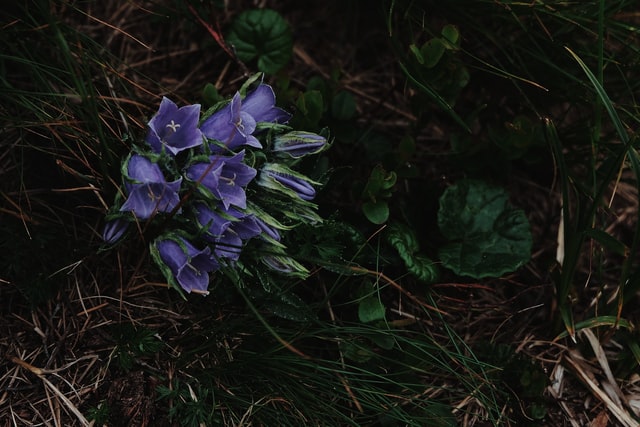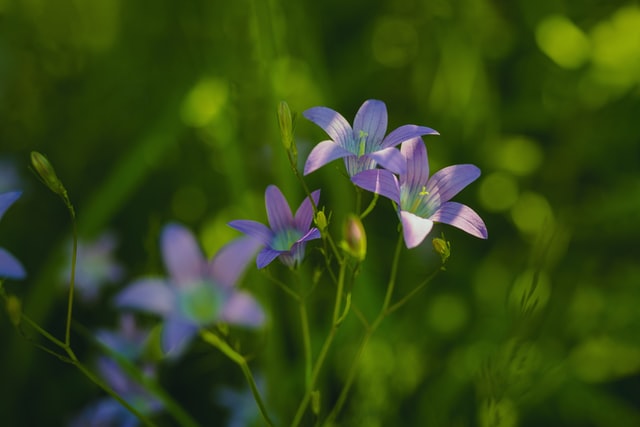As an Amazon Associate, I earn from qualifying purchases
Campanula Bellflower plants are a favorite of many gardeners. They are easy to grow, and come back every year. In this blog post, we will discuss everything you need to know about Campanula Bellflowers. We will cover watering, planting, propagation, pests and diseases, and USDA zones. We will also discuss the different varieties of Campanula Bellflowers available. So read on to learn more about these beautiful plants!
Campanula bellflowers are a beautiful addition to any garden. They come in many colors, and can be planted in sun or shade. They are hardy plants that come back every year, and can even be propagated easily! In this article, we will discuss everything you need to know about Campanula bellflowers.

Photo by Oleksandra Bardash on Unsplash
Campanula Bellflowers care guide
Sun or Shade?
Campanula bellflowers can be planted in either sun or shade. However, they will perform best in full sun. If you are planting them in a shady area, make sure the soil is moist and well-drained.
Soil Requirements
Campanula bellflowers prefer well-drained soil. They will not do well in wet soil, so make sure to plant them in an area that has good drainage.
Watering Requirements
Campanula bellflowers should be watered regularly, especially during the hot summer months. Make sure to water them deeply, and avoid getting the leaves wet.
Campanula bellflowers need regular watering to thrive. In hot weather, water them every day; in cooler weather, water them every other day. Make sure the soil is moist at all times, but do not overwater your plants or they will rot.

Photo by Julia Zyablova on Unsplash
Fertilizing
Campanula bellflowers do not need much fertilizing. A light application of fertilizer once a year is usually enough.
USDA Zones
Campanula bellflower plants grow best in USDA zones five through eight. However, they can be grown in other zones if you are willing to provide extra care.
Soil Requirements
Campanula bellflowers prefer rich, well-drained soil. Add some compost to your garden bed before planting your Campanulas to ensure that they have plenty of nutrients.
Planting:
Campanula bellflowers can be planted in sun or shade. They are hardy plants that come back every year, and can even be propagated easily!
Height:
Campanula bellflowers typically grow to a height of 12-18 inches.
Flowering Time:
Campanula bellflowers typically flower from late spring through early fall.
Color:
Campanula bellflowers come in many colors, including white, blue, purple, and pink.
Width:
Campanula bellflowers typically have a width of 12-18 inches.
History:
Campanula bellflowers have a long history, dating back to the 1600s. They were first grown in Europe, and later spread to North America.
Varieties:
There are many different varieties of Campanula bellflowers available. Some of the most popular include Cupid, Loddon Royalist, and Spencer Blue. These plants come in a variety of colors, including blue, white, pink, and purple.
• ‘Blue Clips’ – This variety has bright blue flowers and grows to a height of 12-18 inches.
• ‘Blue Dream’ – This variety has deep blue flowers and grows to a height of 18-24 inches.
• ‘Cambridge Blue’ – This variety has light blue flowers and grows to a height of 12-18 inches.
• ‘Campanula lactiflora’ – This variety is also known as the Harebell, and has pink or white flowers that grow up to 24 inches tall.
- Dwarf Bellflowers
- American Bellflower
- Carpathian Harebell
- Bluebells
- Scotch Bluebell
Propagation:
Campanula bellflowers can be propagated easily from seed or division. To propagate from seed, simply sow the seeds in the springtime and water them regularly. To propagate from division, divide the clumps of plants in the springtime and replant them elsewhere in your garden.
Can you grow Campanula Bellflower plants indoors?
Campanula bellflowers can also be grown indoors in pots. They do well in sunny or shady locations, and prefer moist soil.
Are they perennials?
Campanula bellflowers are perennial plants that come back every year.
Do I need to plant a Campanula Bellflower plant in shade or sun?
Campanula bellflowers can be planted in either sun or shade. However, they will perform best in full sun. If you are planting them in a shady area, make sure the soil is moist and well-drained.
What other names are Campanula Bellflowers known by?
Some other common names for Campanula bellflowers include Canterbury bells, Harebells, and Scottish bells.
Are they hardy?
Campanula bellflowers are hardy plants that can withstand frost and cold weather.
How to deadhead the Campanula Bell flower plant
To deadhead the Campanula bellflower, simply pinch off the spent flowers at the stem. This will encourage new blooms to form.
Can you grow Campanula Bellflower plants in pots?
Campanula bellflowers can be grown in pots indoors or outdoors. They do well in sunny or shady locations, and prefer moist soil.
Is it a good indoor plant?
Yes, Campanula bellflowers make excellent indoor plants. They do well in sunny or shady locations, and prefer moist soil.
Do they need to be planted in the shade?
No, Campanula bellflowers can be planted in either sun or shade. However, they will perform best in full sun if you are planting them outdoors. If you are planting them indoors, they can grow well in both sunny and shady locations.
What are the pests and diseases that can affect Campanula Bellflower plants?
Campanula bellflowers are generally pest and disease free, but they can occasionally be affected by aphids or powdery mildew. If this happens, you can treat the plants with a pesticide or fungicide.
How do I propagate Campanula bellflower plants?
Campanula bellflowers can be propagated easily from seed or division. To propagate from seed, simply sow the seeds in the springtime and water them regularly. To propagate from division, divide the clumps of plants in the springtime and replant them elsewhere in your garden.
Uses for Campanula Bellflower in your garden
Campanula bellflowers can be used in many different ways in your garden. They make excellent groundcovers, and can also be planted in containers or used as an edging plant or in borders. Their pretty blooms will add color to any garden bed!
Looking for a flowering groundcover that does well in both sun and shade? Look no further than Campanula bellflower plants! These beautiful flowers come in a variety of colors, including blue, white, pink, and purple. They are hardy plants that can withstand frost and cold weather, making them a great choice for gardens in USDA zones five through eight.
If you’re looking for a beautiful addition to your garden, consider planting Campanula bellflowers. These hardy plants come in many colors, and can be planted in sun or shade. They are also easy to propagate, so you can quickly and easily create new plants!
So there you have it! Everything you need to know about Campanula bellflowers. These beautiful plants are easy to care for, and come back every year. So why not add them to your garden today?